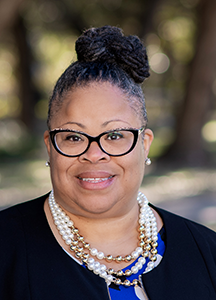• by Paula Johnson, Ph.D. • IDRA Newsletter • October 2020 •


Oftentimes, disparities are due to structural barriers. For example, among high schools with the highest percentages of Black and Latino students, one in four do not even offer Algebra 2, and one in three do not offer chemistry (Frost & Worthen, 2015). And other types of barriers can be harder to see.
The IDRA EAC-South helps school districts identify and address barriers to higher level courses and advanced programs. We examine key indicators, such as:
- Policies and entrance procedures that may be subjective;
- Instructional supports and academic development for students;
- Strategies, coaching and professional development for teachers; and
- Family engagement for awareness of available academic program opportunities.
The IDRA EAC-South is one of four federally-funded centers that provide technical assistance and training at the request of school districts to build capacity of local educators to ensure a more equitable learning environment for all students. Working in collaboration with several districts across the U.S. South, we assist leaders in making connections between educational policy and instructional practice that prevent entrance into advanced courses and programs for students of color.
Achievement gaps in this country have just as much, if not more, to do with policies, decisions and practices designed and implemented by adults as they do with students’ academic abilities.
For example, school district partners in Alabama and Florida collected, tracked and analyzed data on access, recruitment and enrollment in gifted and higher-level programs and courses. District policymakers then examined data trends with a critical review of practices and policies focusing on racial disparities.


- How does the district assure that the process for identifying and testing students is equitable?
- What second-chance opportunities are the district providing to identify and enroll underrepresented students?
- What gateway programs and acceleration courses are available to prepare students of color and other underrepresented groups?
- How are teachers building instructional rigor to support the diverse learning needs of students?
- What engagement approaches are teachers using to counter challenges for underrepresented students?
- How do teachers incorporate differentiated instruction to support the social-emotional learning needs of underserved students?
The IDRA EAC-South also is working with instructional leaders in Florida and Virginia to increase their capacity to ensure equitable access to college and career readiness academic programs and to advise students and their parents in course selection. By conducting a comprehensive educational opportunity assessment of each of its high schools, middle schools and elementary schools, districts can determine if they are providing all students, particularly Black and Latino students, with a rigorous education to prepare them for college and careers.
The districts are using the findings to inform development of action plans to expand educational opportunities for underrepresented students, promote a college and career culture, and increase family engagement at all grade levels. They will conduct surveys to measure the level of effectiveness of home-school communication practices related to course options and college and career pathways.
Achievement gaps in this country have just as much, if not more, to do with policies, decisions and practices designed and implemented by adults as they do with students’ academic abilities. It is critical to conduct ongoing assessment of these influencing factors when reviewing the performance of students of color in education programs. All students deserve the opportunity to enroll and excel in rigorous and challenging coursework.
For more information on technical assistance services, see www.idraeacsouth.org.
Resources
Blanchard, M.A. (2020). Choosing the Gap: Understanding the Advanced Placement Enrollment Choices of Black Students. The George Washington University.
Frost, D., & Worthen, M. (November 2015). Course Access: Providing Equitable Access to High-Quality Learning Opportunities. International Association for K–12 Online Learning (iNACOL).
Paula Johnson, Ph.D., directs the IDRA EAC-South. Comments and questions may be directed to her via email at paula.johnson@idra.org.
[©2020, IDRA. This article originally appeared in the October 2020 IDRA Newsletter by the Intercultural Development Research Association. Permission to reproduce this article is granted provided the article is reprinted in its entirety and proper credit is given to IDRA and the author.]


